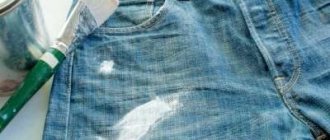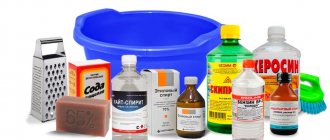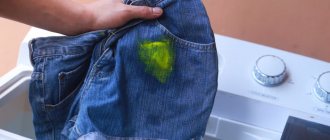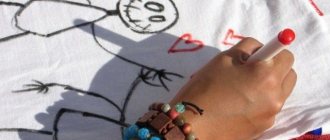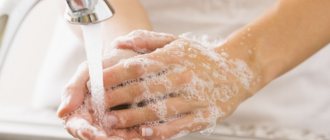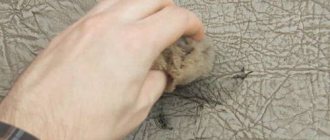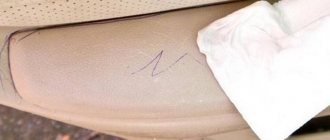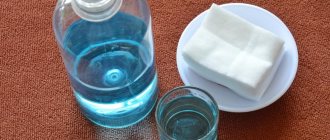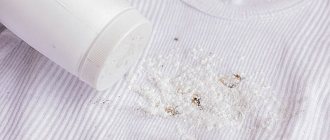It is pants that most often suffer from paint. You can put a stain anywhere, for example, by sitting on a bench in the park and staining the thing with paint from the bench.
If you discover contamination, there is no need to despair. The thing can be completely rehabilitated. Both improvised means and professional stain removers come to the rescue.
Let's look in more detail at how and with what you can remove fresh and already dried paint from pants (white, black, etc.) at home.
Things to consider
- If the item is expensive and you are afraid to take risks, it is better to immediately take it to the dry cleaner.
- If you want to clean the dirt yourself, don’t delay it. Try to scrub off the paint within the next few hours after the stain appears.
- If the paint has had time to dry thoroughly, first very carefully scrape off the top layer with a blade. This will make it easier to wash it off. But if the fabric is quite delicate, it is better not to use a blade, otherwise you may accidentally tear it.
- All the methods below are working. They have been tested by real people who have shared their experiences on various forums. But very often it is not clear what kind of paint left the mark. Therefore, if the product does not help, perhaps it is simply not suitable for the substance in which your item is stained.
- If the stain is large, you can try several products on it at once in different areas. This way you will know which method will definitely help you. If the stain is small and the chosen product cannot cope with it, just try another one, lightly rinsing off the previous one with water.
- Also test the selected product first on an inconspicuous area of clothing. This will ensure that the color of the fabric is not affected.
- You can rub the product into a rough cloth with any brush or the back of a dishwashing sponge. For delicate stains, it is better to rub it with your hands or clean the stain with the fabric itself, as when washing.
Types of pollution
The reason is different types of paint. They differ in their purpose and functionality, therefore they have different composition, consistency and chemical properties. All characteristics are taken into account when choosing a suitable product.
- Paints for painting. All types contain two mandatory components: coloring parchment and an adhesive base. Watercolor and gouache have a similar composition: they contain resin, gum, and sometimes honey. They dissolve easily in water. Oil varieties add oils, beeswax and soft resin. They are much more labor-intensive to remove, since they do not dissolve in water. Tempera paints are also difficult to remove: they contain egg yolk, wax, and are oil-based.
- For repairs (silicone, oil, alkyd). Oily ones contain drying oils and oils; they are quite durable. Silicone includes water, resin, organic elements.
- Cosmetic (for hair, eyebrows and eyelashes): pigment and ammonia.
- Food.
The most problematic varieties are repair paints. Kinds:
- Oily. The composition includes pigment powder and synthetic oil. They are unstable to alkaline environments.
- Alkyd. Made on the basis of alkyd varnish with the addition of solvent.
- Water-based. Quick-drying material, composition pigments and water.
- Latex. The composition is based on acrylic resin.
- Enamel. Material: glass powder. Form a dense protective layer on the surface.
The most difficult to remove are enamel and latex paints. Their composition does not allow them to dissolve quickly. It is IMPORTANT to wash off the stain immediately, otherwise it will be almost impossible to wash it later.
Briefly about the main thing
Experts, talking about how to remove paint from clothes, advise acting decisively and not waiting for the stains to completely dry. The method of removing them is chosen taking into account the quality of the material, the length of time the blot remains, and the composition of the paint itself. Watercolor, gouache and water-based emulsion can be washed off with ordinary water; you will have to tinker with other types of stains, but there is a chance to save your favorite clothes. All the control options listed in the article are effective and tested in practice.
Ratings 0
Clean clothes from hair dye
Due to their poor financial condition, women often resort to dyeing their hair at home. People are turning less and less to hairdressers and hairdressers. During the dyeing process, unexpected stains may arise that make you wonder how to remove hair dye from clothes. This type is especially durable because it must remain on the hair even when washed with shampoo or other detergents. You need to act as quickly as possible. You can get rid of fresh stains using regular hairspray or washing.
The most difficult thing to remove is an old stain on clothing. Try using hydrogen peroxide, but it can discolor fabrics, so it's only suitable for white items. Treat the stain and leave for half an hour. Rinse off the residue and throw the item in the wash.
Synthetics and wool are best cleaned with vinegar. If an item contains henna, it requires a special approach. You will need a solution of hydrogen peroxide, ammonia and water. Mix thoroughly, treat the stain and leave for a few minutes. All that remains is to wipe off the residue and wash it.
Enemies of acrylic
If acrylic paint appeared on clothes a long time ago, it will be difficult to deal with it. Try using solvent solvents and then use an ammonia-vinegar mixture.
Ammonia and vinegar
Peculiarities. A mixture of ammonia and vinegar will also help remove acrylic paint stains from clothes. To enhance the effect, add regular table salt to the main components.
Let's start washing
- Mix vinegar and ammonia. The components must be taken in the same quantity - two tablespoons each.
- Add salt to the mixture. You will need about a tablespoon, but you can use your eye - the paste should turn out runny.
- Apply the mixture to the stained cloth.
- Scrub gently with an old toothbrush.
- Wash it. Use the normal wash cycle for the garment.
Video on the topic
How can you clean black and white trousers?
Black trousers should be washed carefully, without using aggressive agents, such as solvent 646 or acetone. You can use:
- turpentine;
- laundry soap;
- professional stain removers for washing colored laundry.
Black trousers should not be rubbed or wrung out intensively. They need to be washed at low temperatures.
If the trousers are white, then use such means as:
- alcohol;
- soda;
- glycerol;
- soap solution;
- solvents;
- white clay and refined gasoline;
- ammonia.
Wash without damaging: 4 tips
In the fight against “blots”, it is important not to damage your favorite jeans. To return your clothes to a presentable appearance without ruining them, follow these four tips:
- Act immediately. If you see dirt on denim, clean it. The more time has passed, the less likely it is to save your denim shorts or pants. The paint eats into the fibers of the fabric and will not be easy to get rid of. Especially if the item is made of thick material.
- Check. Before using a solvent, make sure it will not cause any harm. Test from the wrong side. The best place for a “test drive” is the seam.
- Handle correctly. To avoid streaks and the spread of contamination, cleaning products must be applied to the dirty area correctly - moving from the edge to the center.
- Follow the instructions. The instructions were invented for a reason. Overexpose a strong solvent and you will get a hole.
First aid
The easiest way to deal with a fresh stain. Any paint that has just spilled onto your pants can be easily removed with regular washing powder.
Algorithm of actions to follow:
- moisten the stain with water or apply a damp disposable cloth to it;
- Apply washing powder to the stain;
- rub with a brush until soap foam forms;
- leave to soak for 15-30 minutes;
- wash your trousers as usual.
This method is only suitable if the paint is on the pants for no more than 1-2 hours.
Wash off the emulsion
Water-based paint washes off easily. You just need to not hesitate to take action. How to remove fresh paint from clothes? Wash the soiled item with laundry soap. You can throw your clothes in the washing machine and add a good store-bought stain remover and you'll end up with a clean item.
To remove old paint from clothes, first moisten the stain with alcohol. Under its influence, water-based façade paint disappears before your eyes. Does not help? Enhance the effect of alcohol with salt:
- sprinkle the stain with salt (about a teaspoon);
- pour alcohol on top of the salt;
- wait an hour and put it in the machine.
How to remove dried paint from clothes
The hardest thing to remove from clothes is dried paint. It is better not to let this happen, but sometimes you may not see the contamination in time. In such cases, the most serious and aggressive means are used. First, remove dried paint mechanically using a non-sharp object. Try not to damage the fabric while doing this. Buy purified gasoline and use a cotton pad to treat the stain. The procedure should dissolve the bulk of the dye. In the process, replace the contaminated cotton wool with new one. At the end, create a soda solution and treat the surface with a sponge. To remove residues and the smell of gasoline, wash the item.
What means to use
So, among the many chemicals, we can highlight the following, which do an excellent job with various stains:
- The simplest is sunflower oil . This food product copes well with these types of contaminants. It is simply rubbed into the stained area. The only disadvantage of vegetable oil in this case is that it itself must be removed later;
- Solvent or White Spirit . This solvent is used specifically for removing paint from various objects. But you need to be very careful with it, since it eats away not only dirt, but also the color of the clothes themselves;
In the photo - White spirit in various containers
- Some special chemicals are often called stain removers . You also need to be very careful with such funds. They usually come with instructions. Before you wash the paint off your pants, it’s best to familiarize yourself with it;
Before removing paint from your pants, you should read the instructions for the chemical.
- Acetone . Another type of solvent that can not only clean, but also harm fabrics is that it leaves light stains;
- Laundry soap . The safest remedy. Even in very large quantities it is not capable of harming clothing.
Advice! You should use products such as acetone, solvents, and others only on light-colored items.
Basic Rules
To avoid having to throw away your suit, you should follow a few simple rules.
- If possible, paint removal should begin immediately after the incident. The earlier the better. It will be easier to wash off the stain before the paint has completely saturated the fabric. After drying, there is a higher risk of not saving the clothes.
- It is advisable to know what kind of paint the outfit was damaged by. Depending on the type, different methods are used. In one case, plain water is enough to remove the mark. In other cases (for example, to wash off water-based paint), it is hardly possible to do without a solvent. What the outfit is made of also matters.
- In order not to spoil the fabric, manipulations should be carried out from the inside out. Place napkins on the front side to absorb the solvent and remaining dissolved paint.
